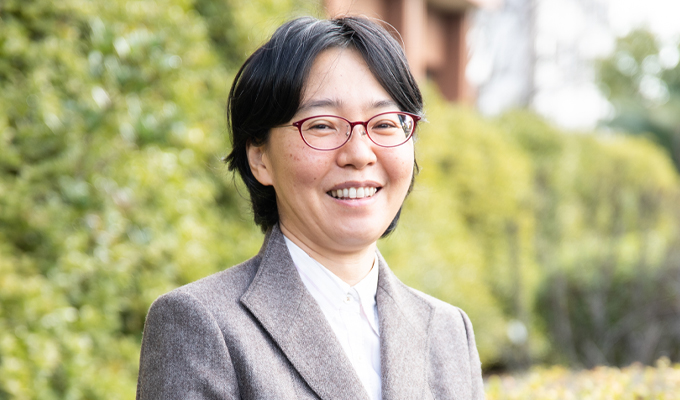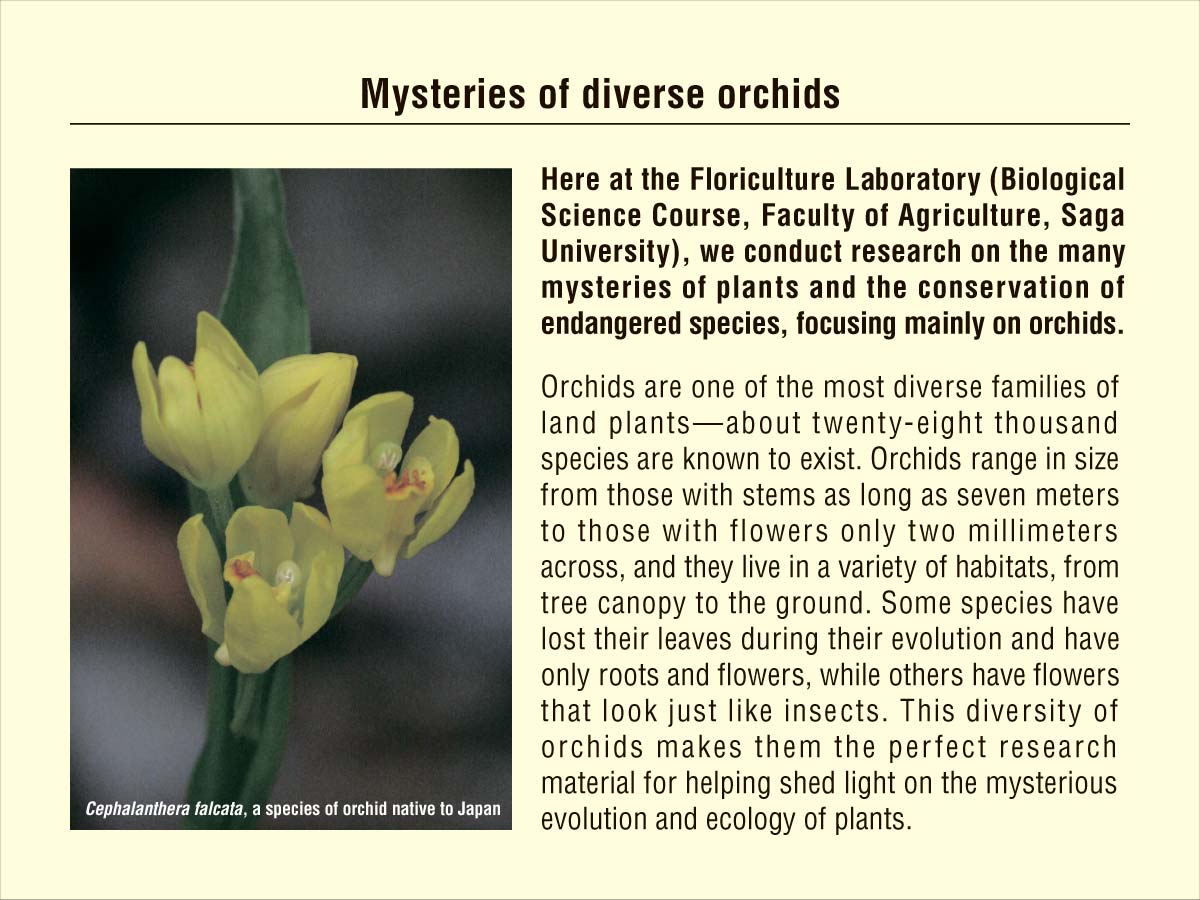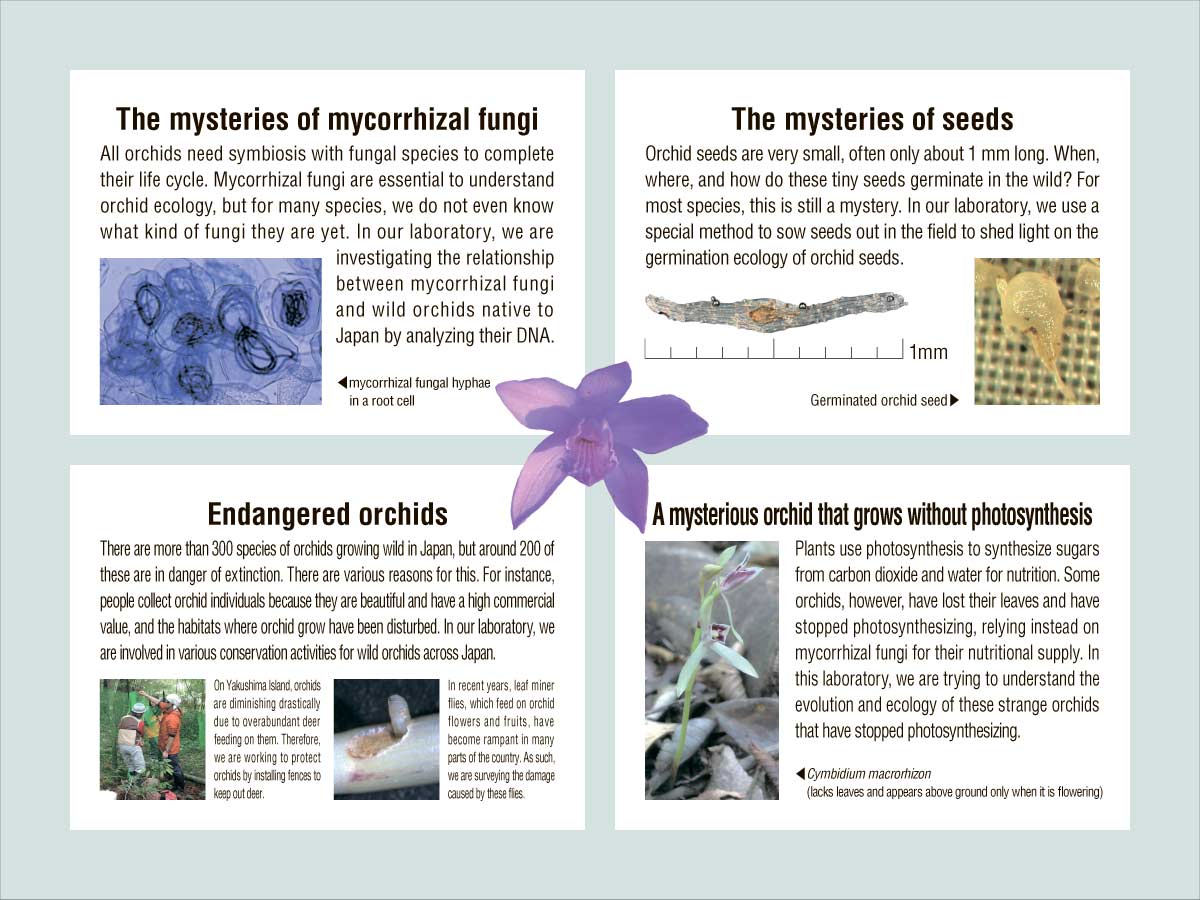Mycorrhizal symbiosis in orchids, conservation of endangered plants
Research overview
Unlocking the secrets of orchid evolution and ecology, and helping conserve endangered species Solving the mysteries of orchids
Orchids are one of the most diverse families of land plants—about twenty-eight thousand species are known to exist. Orchids form strong associations with fungi in their roots. These fungi are called mycorrhizal fungi, and there are still many mysteries concerning their ecology that remain unsolved. At our laboratory, we are working to unlock the secrets of orchid evolution and ecology, and are also studying how to conserve endangered species.
■Field surveys
A few times a year, we conduct field surveys in Yakushima, Iriomote Island, and Okinawa Island, where there are diverse orchid populations due to the ideal warm climate of these islands. In our research, we take samples of orchids and their roots, and cultivate them in vitro, conduct molecular experiments, and observe them under microscopes. When we are unable to visit in person, as was the case in 2020, we ask local institutions with which we collaborating to collect orchid samples and send them to us for analysis.
■Solving the mysteries of Erythrochis altissima
In 2018, we succeeded in determining how the orchid Erythrochis altissima uses nutrients from mycorrhizal fungi to grow without photosynthesis. Erythrochis altissima is the world’s largest myco-heterotrophic plant. In Japan, it only grows in the wild in Kagoshima and Okinawa, and it has been designated as Critically Endangered (CR). We have discovered thirty seven types of fungi in these Erythrochis roots, and proved by analyzing their composition that the orchids and fungi have a symbiotic relationship.
■Developing technologies for DNA analysis
In the course of analyzing fungal DNA, we discovered that there are many orchid mycorrhizae that cannot be detected with the next-generation sequencers used in recent years. So, to achieve a more accurate level of detection, we are currently developing a DNA barcoding technique that uses novel primer combinations. If we can establish this technique, then it will have broad applications in the field of fungal DNA analysis.
There are more than 300 species of orchids growing wild in Japan, but around 70% of these are in danger of extinction. While conducting conservation activities for wild orchids in various parts of the country, our laboratory is also working among other things to shed light on the germination ecology of orchid seeds, carry out research on symbiotic fungi, and study flies that damage seeds, all of which are essential for increasing orchid populations.
We are currently conducting a joint study with a research organization in Okinawa. However, in the future, we would like to undertake joint research in northern Japan and abroad so that we can clarify a wider range of other ecological relationships.
Message
In addition to deepening our basic knowledge of mycorrhizal symbiosis between plants and fungi, I seek to use the insights gained through research to help conserve endangered species. I carry out a wide range of research activities, involving field surveys, in vitro cultivation, molecular experiments, and observations under a microscope. This enables students in my laboratory to learn a variety of techniques.
Main publications
- Ogura-Tsujita, Y., Yukawa, T., Knoshita, A. (2021) Evolutionary history and mycorrhizal association of mycoheterotrophic plants depending on saprotrophic fungi. Journal of Plant Research, in press.
- Rammitsu, K., Yukawa, T., Yamashita, Y., Isshiki, S., & Ogura‐Tsujita, Y. (2020). The mycorrhizal community of the epiphytic orchid Thrixspermum japonicum is strongly biased toward a single Ceratobasidiaceae fungus, despite a wide range of fungal partners. American Journal of Botany, 107:1654-1662.
- Ogura-Tsujita, Y., Gebauer, G., Xu, H., Fukasawa, Y., Umata, H., Tetsuka, K., Kubota, M., Schweiger, JMI., Maki, M., Isshiki, S., Yukawa, T. (2018). The giant mycoheterotrophic orchid Erythrorchis altissima is associated mainly with a divergent set of wood‐decaying fungi. Molecular Ecology, 27(5), 1324-1337.
- Ogura‐Tsujita, Y., Yokoyama, J., Miyoshi, K., & Yukawa, T. (2012). Shifts in mycorrhizal fungi during the evolution of autotrophy to mycoheterotrophy in Cymbidium (Orchidaceae). American Journal of Botany, 99(7), 1158-1176.
- Ogura-Tsujita, Y., Gebauer, G., Hashimoto, T., Umata, H., & Yukawa, T. (2009). Evidence for novel and specialized mycorrhizal parasitism: the orchid Gastrodia confusa gains carbon from saprotrophic Mycena. Proceedings of the Royal Society B: Biological Sciences, 276(1657), 761-767.








